|
Yakety-Yak...
1/48 Scratchbuilt
Yak-28P Firebar
by "Bondo" Phil Brandt
|
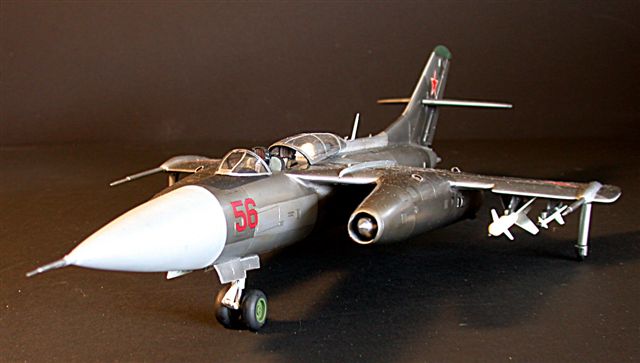 |
|
Yak-28P Firebar |

HyperScale is proudly sponsored by Squadron
The Yak-28P interceptor
represents the penultimate iteration of the venerable Yakovlev twin-jet
fighter/bomber family (Yak-25/26/27/28) which, in the form of the Yak-25
"Flashlight", first flew in the early Fifties. The sharply swept wings,
huge radome and bicycle landing gear of the Firebar lend a certain "swoopiness"
which, in this modeler's opinion, perhaps best represents Evil Empire
Cold War fighter design philosophy. The close-held, last-of-the-line
Firebar was never exported, but defended the borders of the Soviet
Motherland (along with the Su-15 Flagon of KAL shootdown infamy) until
1988 when the Mig-31 Foxhound began to be produced in quantity.
Until Collect-Aire released a not-bad 1/48 resin Flashlight kit circa
2002, the only other Yak-25/26/27/28 kits extant were the ancient (1956)
Revell box-scale Flashlight, the Victoria Models mutimedia 1/48
Flashlight and the two-for-one Contrail vac kit (Firebar and Brewer)
whose scale is generally considered somewhat larger than 1/72. The most
recent 1/72 release is an injected one by Amodel, and as one might
expect, the Ukrainians have produced the definitive model of this bird.
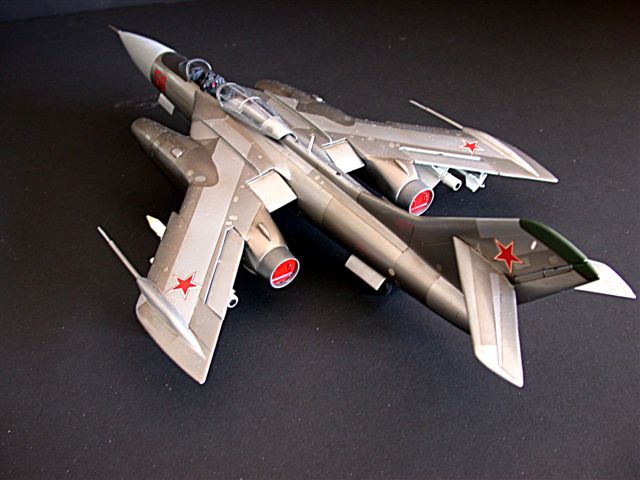
Although it was my understanding that, following their Flashlight kit,
Collect-Aire was going to do various Yak family sequels, such releases
have, to date, not materialized. Accordingly, the Scratchbuilding
Division of Bondo Industries elected to press on with its own Firebar
rendition.
"Aviatsiya Magazine",
published in Russia, always has great 1/72 plans, with much detail. I
enlarged these to 1/48. The mag's text is, of course, in Russian, but
the pictures and plans speak for themselves. An even larger (and in
English) publication (Midlands Publishing) is the recent Aerofax book on
the whole Yak-25-28 family by the prolific author, Jefim Gordon There
are more pictures than you'll ever need....except, unfortunately,
closeup details. A plate of color sideviews is included in the appendix.
I bought the Amodel 1/72 injected Yak-28 kit from Linden Hill Imports to
use as a 3D example. It was most useful in building the bicycle landing
gear and wheel wells.
Fuselage
As this boy hotrodder did
in the Fifties, I prefer to adapt already available components which
have the general shape desired. The huge centerline fuel pod of the
Monogram B-58 filled the bill for the torpedo-like Firebar fuselage. The
tank was split horizontally so that a cockpit and maingear bays could be
fashioned from plastic sheet. The long, ogival radome came from a
vacuformed Polish HitKit of the Flagon. The radome was filled with epoxy
putty and adapted to the B-58 tank.
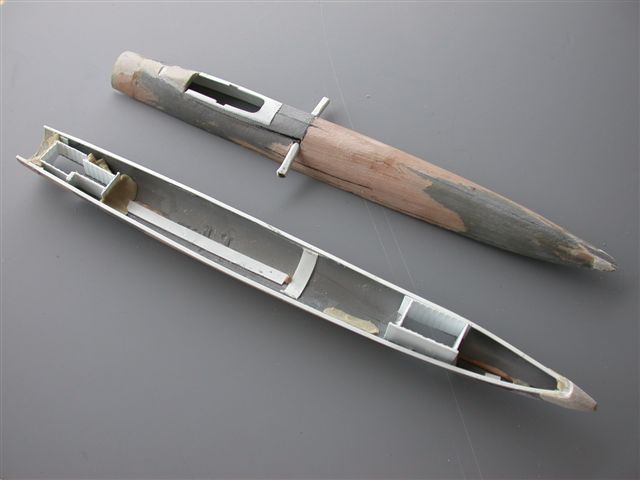
The cockpit outline piece
came from that area on the Revell F-89 and was integrated with the basic
fuselage pod.
Cockpit
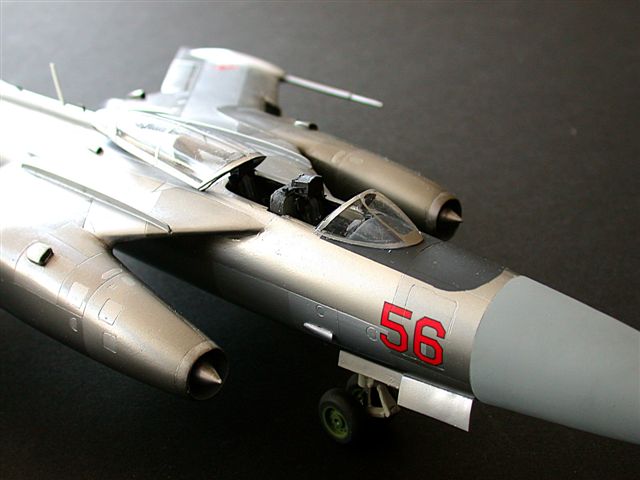
Because the cockpit tub of the Firebar is strongly reminiscent of its
progenitor, the Flashlight, I cloned (in resin) the two-place tub and
instrument panels from the Collect-Aire Flashlight kit. Seats are
Neomega KK-2s. Sidewall detail was added using artistic license, since I
was unable to obtain interior pix of same.
Landing Gear
Maingear wheel bays were
formed from plastic sheet, and the struts built from parts box
components and brass tubing. Main wheels are from the 1/48 Lindberg
Mig-31. Outriggers were fashioned from Monogram Harrier units, with
scratchbuilt bay doors made from plastic tubing. Gear doors were
laminated from sheet.
Engines
The long-nosed,
semi-podded engines were built from Plexiglas tube, brass tube, plastic
sheet and lots of epoxy putty! Kitbashed afterburner cans (decreased
diameter) came from the Zhengdefu ripoff of the Academy F-111 kit.
Intake spikes are modified from the monogram B-58. The engines are
canted vertically from the significant anhedral of the wings. Because of
the thick Plexiglas tubing used as the "keel" of each engine assembly,
doing turbine/afterburner interior details was bypassed in favor of
scratchbuilt typical red Soviet FOD covers.
Wings
The Hobbycraft Cutlass
furnished the inner wings, transitioning to the outer units which were
made from the venerable Hawk/Testors OV-10.

Flaps came from the
Cutlass, and the ailerons and leading edge extensions were scratchbuilt.
The faired-in wingtip "bullets" which house the outriggers were created
from the ends of Mk 82 bombs with the center sections from plastic tube.
Proper wing anhedral was achieved by a sturdy bent brass carry-through
rod epoxied through the fuselage. The long, slender spikes jutting
forward from each wingtip were built from two diameters of thin brass
tube.
Tail

The vertical fin, rudder and stabs were created from those of the Heller
RF-84F kit.
Windscreen / Canopy
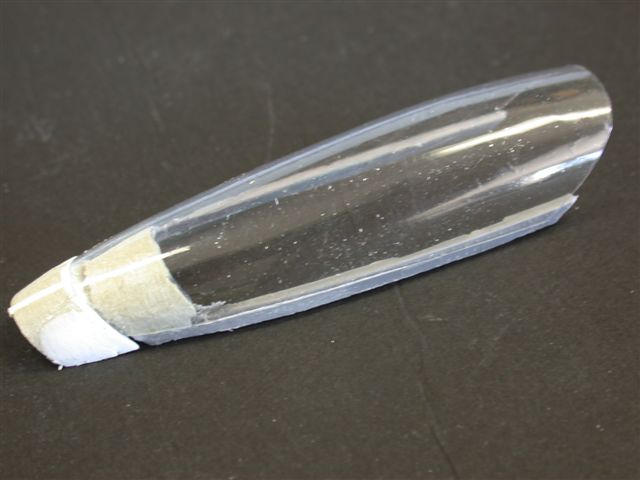
I was unable to find a suitable existing canopy assembly, so I carved a
master and vacuformed same. The canopy interior rails came from the
Revell F-89, the aft canopy bulkhead was scratchbuilt and the
canopy/windscreen arches were Dremelled out of .060 sheet.
Weapons
Pylons were scratchbuilt
and mounted to the wings with brass tube. The large radar and IR
missiles are from the Trumpeter Flagon kit, and the Sidewinder-like IR
Atolls from the Monogram Harrier.
Natural Metal
After coating all
components with gray automotive lacquer primer, the overall surface was
practically immersed in repeated iterations of my favorite lacquer
putty, 3M Blue Acryl. Although it does shrink if applied too thickly,
its quick drying and sandabilty are IMO unmatched. I also used Mr.
Surfacer and slow drying CA glue for major discrepancies. Panel lines
were also scribed at this time. Final wetsanding of the primer was with
12,000 grit.
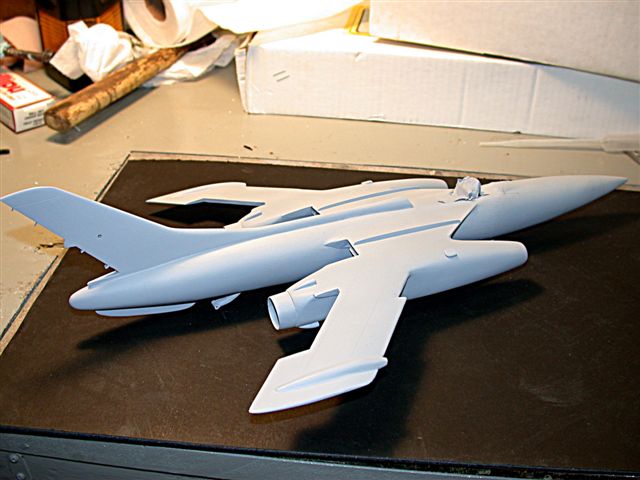
Alclad was, as usual, the NMF of choice. I used four basic shades with
two custom blended ones thrown in. The shade differentiation may seem
fairly strong, but the cover of the above-mentioned Aerofax book has a
color shot of just such a strongly contrasting metal panel mix. The
radome was done in acrylic Dark Gunship Gray.
Markings
The typical Soviet
aircraft of the time was unadorned save for the requisite Soviet stars
and fuselage number. The stars came from an Aeromaster sheet, and the
numbers from the forthcoming Collect-Aire Mig-31.
It has been a real Chinese
fire drill, and I know where the mistakes and shortcuts are. But, it's
over now, I'm glad, and the Firebar has been blooded in competition at
the Phoenix Nats.
Time to give the total
scratchbuilding a rest, and get on with other less involved kitbashes at
the Weirdness Division of Bondo Industries.
Click on the thumbnails
below to view larger images:
Model, Images and Text Copyright ©
2004 by Phil Brandt
Page Created 13 October, 2004
Last Updated
14 April, 2005
Back to
HyperScale Main Page
|
Home
| What's New |
Features |
Gallery |
Reviews |
Reference |
Forum |
Search